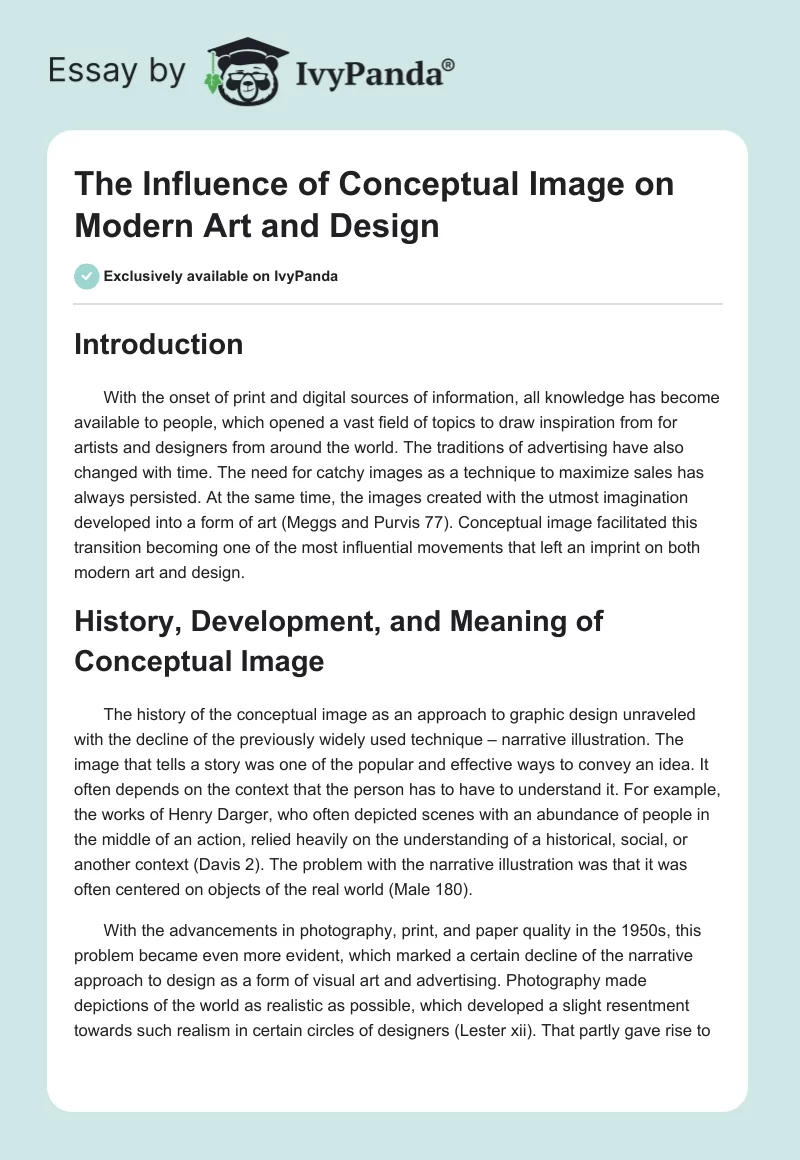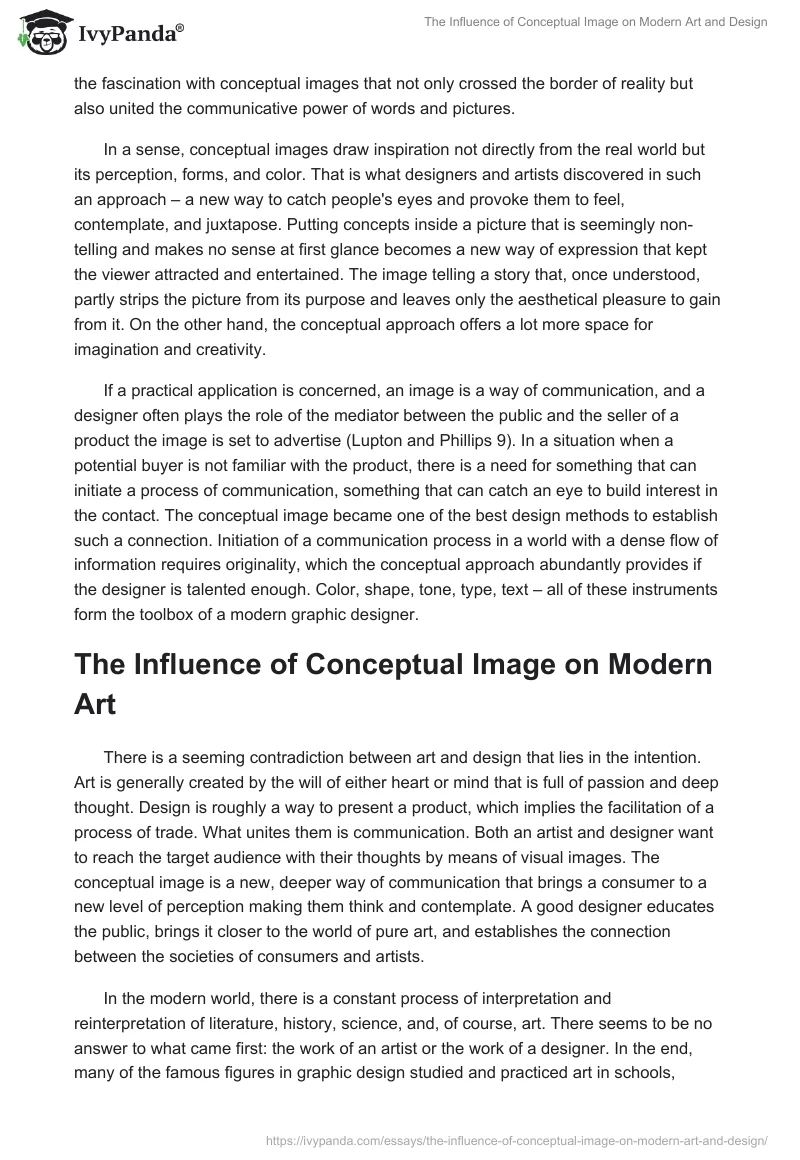Introduction
With the onset of print and digital sources of information, all knowledge has become available to people, which opened a vast field of topics to draw inspiration from for artists and designers from around the world. The traditions of advertising have also changed with time. The need for catchy images as a technique to maximize sales has always persisted. At the same time, the images created with the utmost imagination developed into a form of art (Meggs and Purvis 77). Conceptual image facilitated this transition becoming one of the most influential movements that left an imprint on both modern art and design.
History, Development, and Meaning of Conceptual Image
The history of the conceptual image as an approach to graphic design unraveled with the decline of the previously widely used technique – narrative illustration. The image that tells a story was one of the popular and effective ways to convey an idea. It often depends on the context that the person has to have to understand it. For example, the works of Henry Darger, who often depicted scenes with an abundance of people in the middle of an action, relied heavily on the understanding of a historical, social, or another context (Davis 2). The problem with the narrative illustration was that it was often centered on objects of the real world (Male 180).
With the advancements in photography, print, and paper quality in the 1950s, this problem became even more evident, which marked a certain decline of the narrative approach to design as a form of visual art and advertising. Photography made depictions of the world as realistic as possible, which developed a slight resentment towards such realism in certain circles of designers (Lester xii). That partly gave rise to the fascination with conceptual images that not only crossed the border of reality but also united the communicative power of words and pictures.
In a sense, conceptual images draw inspiration not directly from the real world but its perception, forms, and color. That is what designers and artists discovered in such an approach – a new way to catch people’s eyes and provoke them to feel, contemplate, and juxtapose. Putting concepts inside a picture that is seemingly non-telling and makes no sense at first glance becomes a new way of expression that kept the viewer attracted and entertained. The image telling a story that, once understood, partly strips the picture from its purpose and leaves only the aesthetical pleasure to gain from it. On the other hand, the conceptual approach offers a lot more space for imagination and creativity.
If a practical application is concerned, an image is a way of communication, and a designer often plays the role of the mediator between the public and the seller of a product the image is set to advertise (Lupton and Phillips 9). In a situation when a potential buyer is not familiar with the product, there is a need for something that can initiate a process of communication, something that can catch an eye to build interest in the contact. The conceptual image became one of the best design methods to establish such a connection. Initiation of a communication process in a world with a dense flow of information requires originality, which the conceptual approach abundantly provides if the designer is talented enough. Color, shape, tone, type, text – all of these instruments form the toolbox of a modern graphic designer.
The Influence of Conceptual Image on Modern Art
There is a seeming contradiction between art and design that lies in the intention. Art is generally created by the will of either heart or mind that is full of passion and deep thought. Design is roughly a way to present a product, which implies the facilitation of a process of trade. What unites them is communication. Both an artist and designer want to reach the target audience with their thoughts by means of visual images. The conceptual image is a new, deeper way of communication that brings a consumer to a new level of perception making them think and contemplate. A good designer educates the public, brings it closer to the world of pure art, and establishes the connection between the societies of consumers and artists.
In the modern world, there is a constant process of interpretation and reinterpretation of literature, history, science, and, of course, art. There seems to be no answer to what came first: the work of an artist or the work of a designer. In the end, many of the famous figures in graphic design studied and practiced art in schools, colleges, and universities. The emergence of good design works contributed to the erasing of the lines that divided art and design. Provided the visual piece of the advertisement campaign is successful and well known it can be considered a contribution to visual art. For example, the symbol “I love NY” designed by Milton Glaser has become an official logo of a city and launched a wave of similar projects that build identities of numerous cities. It became so influential around the world that it was given a place in the Museum of Modern Art in New York (Sooke para. 3). Thus, the transition from design to art and back is quite unstable and depends on the success and popularity of the work. In the modern world, perhaps, everything that has a concept lying at the base of it can be considered modern art.
The Influence of Conceptual Image on Modern Design
The onset of the conceptual image as a new trend in graphic design if not revolutionized then certainly changed the perception of commercial design significantly. One of the trends graphic designers marked was the use of text as an active element of an image (Meggs and Purvis 466). In the works of conceptual designers like Arnold Varga, words, phrases or letters orchestrated the whole composition, drawing attention and setting the mood. The text ceased to be merely a tool of language but acquired conceptual meaning through rethinking the form of letters, unusual placement, color or texture. Conceptual image, as it was stated above, in its own way built a smarter and more sensitive consumer nurturing their taste for creative advertising and developing a good sense of style.
In the same way, it has also influenced the graphic designers themselves raising the standards of quality and inspiring healthy competition in creativeness. The implicit meaning of the whole image started to play a larger role in graphic design as an advertising technique. Since the middle ages, many commercial posters used objects and words directly related to the subject of advertisement (Meggs and Purvis 151). The conceptual image brought more experiment and creativity. The emergence of a vast variety of music bands and private TV channels in the 60s, 70s, and 80s showed the true power of imagination that was set free with the help of the conceptual image.
Famous Contributors to the Movement
One of the most notable characters who pushed forward the popularity of conceptual images in graphic design was Arnold Varga. In the late 1950s achieved the award “Art Director of the Year.” The latter once more proves the strong ties between good graphic design and art. He believed that honesty and informativeness are the top priority as long as the visual attractiveness stays intact (“Arnold Varga”). He did not think of an advertisement as something that would necessarily make the customer buy the product but as a piece of art that possessed enough information about the item and was creative and attractive.
Another famous contributor to the movement was Seymour Chwast, one of the inventors of Push Pin Graphic. His broad scope of works that included child book illustration, folk art, and comic books made his creations communicate ideas in a non-sophisticated manner. Even the gravest and most serious subjects he managed to depict simply and effectively. His unique style incorporated Victorian-style letters, play with figures, and the complete flatness of the image. Due to his efforts, many people took a different look at common items that surrounded them.
Milton Glaser is also one of the greatest conceptual designers of his time. The world-famous logo of the New York City, School of Visual Arts, Brooklyn Brewery, Bob Dylan album cover, and other famous works were iconized and even now recognized as examples of exceptional design. Many of his works are stored in art museums around the US and the world. Glaser showed the world the implicit power of graphic design stating that the meaning can be put in many different forms and nothing stops one from experimenting.
Conclusion
All things considered, the contribution of the conceptual image movement to modern graphic design and art is immeasurable. Varga, Chwast, Glaser, and others showed that good advertisement and art are strongly connected, and the result of this connection creates a visual culture that shapes minds and develops a taste for beauty. Conceptual image invited people to think rather than to observe, look deeper to grasp the meaning of things.
Works Cited
“Arnold Varga.” History of Graphic Design, n.d. Web.
Davis, Ben.The Insider’s Outsider. 2008. Web.
Lester, Paul Martin. Visual Communication: Images with Messages. Cengage Learning, 2013.
Lupton, Ellen, and Jennifer Cole Phillips. Graphic Design: The New Basics: Revised and Expanded. Chronicle Books, 2015.
Male, Alan. Illustration: A Theoretical and Contextual Perspective. Bloomsbury Publishing, 2017.
Meggs, Philip B., and Alston W. Purvis. Meggs’ History of Graphic Design. John Wiley & Sons, 2016.
Sooke, Alastair. “Milton Glaser: His Heart was in the Right Place.” Telegraph, 2011. Web.


